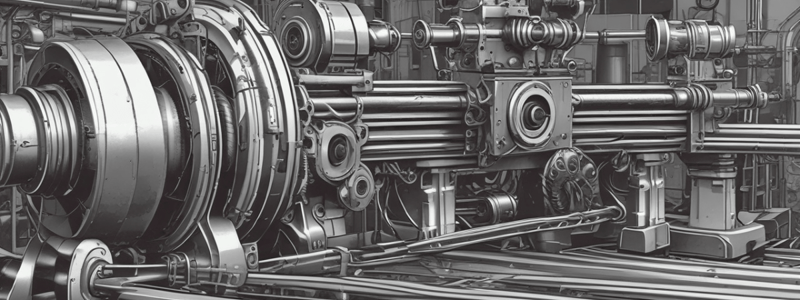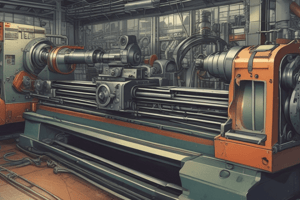Podcast
Questions and Answers
What is the objective of the parallel turning operation?
What is the objective of the parallel turning operation?
- To turn a taper on the lathe
- To verify that the lathe turns parallel to the axis (correct)
- To perform center drilling and reaming operations
- To demonstrate the use of taps and dies
What should you do if the diameter is smaller at the tailstock during parallel turning?
What should you do if the diameter is smaller at the tailstock during parallel turning?
- Adjust the cutting tool to reduce the diameter
- Move the tailstock away from you by half the difference (correct)
- Take another trial cut
- Move the tailstock towards you by half the difference
What is the purpose of the parallel test bar?
What is the purpose of the parallel test bar?
- To measure the diameter of the workpiece
- To check if the dial moves as you move the carriage along the workpiece (correct)
- To mount the cutting tool
- To adjust the tailstock
In what direction should the tailstock be moved if the work is large at the tailstock end?
In what direction should the tailstock be moved if the work is large at the tailstock end?
How many trial cuts should be taken to verify parallel turning accuracy?
How many trial cuts should be taken to verify parallel turning accuracy?
What is the purpose of adjusting the tailstock?
What is the purpose of adjusting the tailstock?
What happens if the diameter is the same on both ends during parallel turning?
What happens if the diameter is the same on both ends during parallel turning?
What is the purpose of the dial indicator on the cross-slide during parallel test bar operation?
What is the purpose of the dial indicator on the cross-slide during parallel test bar operation?
When performing heavy facing operations, what should you do with the carriage?
When performing heavy facing operations, what should you do with the carriage?
What is the purpose of a tool height centering device?
What is the purpose of a tool height centering device?
What is the recommended feed rate for roughing cuts?
What is the recommended feed rate for roughing cuts?
How much should you leave for each finishing cut?
How much should you leave for each finishing cut?
What is the purpose of taking a trial cut in diameter verification?
What is the purpose of taking a trial cut in diameter verification?
What is the effect of backlash on a lathe?
What is the effect of backlash on a lathe?
What does each graduation on the cross-feed dial typically represent?
What does each graduation on the cross-feed dial typically represent?
When adjusting the tool height, how much should you adjust towards you if the workpiece is 0.004 larger at the tailstock?
When adjusting the tool height, how much should you adjust towards you if the workpiece is 0.004 larger at the tailstock?
What is the purpose of the thread center gauge in threading operations?
What is the purpose of the thread center gauge in threading operations?
What is the recommended RPM when using HSS tooling for threading on a lathe?
What is the recommended RPM when using HSS tooling for threading on a lathe?
What is the formula used to calculate the in feed for half angle threading?
What is the formula used to calculate the in feed for half angle threading?
What is the purpose of using a modified die head?
What is the purpose of using a modified die head?
What is the purpose of the compound rest in half angle threading?
What is the purpose of the compound rest in half angle threading?
Why is center height critical in threading operations?
Why is center height critical in threading operations?
What is the formula used to calculate the thread depth in plunge cutting?
What is the formula used to calculate the thread depth in plunge cutting?
What is the purpose of using the spindle face to guide a die?
What is the purpose of using the spindle face to guide a die?
What is a common cause of center drill breakage?
What is a common cause of center drill breakage?
What should be the color of the chip when using HSS drills?
What should be the color of the chip when using HSS drills?
What is the purpose of peck drilling?
What is the purpose of peck drilling?
What is the recommended material allowance for reaming under 1/2 inches?
What is the recommended material allowance for reaming under 1/2 inches?
What is the recommended speed for grooving operations?
What is the recommended speed for grooving operations?
What is a critical consideration when parting a workpiece off?
What is a critical consideration when parting a workpiece off?
What is the recommended RPM for knurling operations?
What is the recommended RPM for knurling operations?
What is the purpose of reversing the workpiece rotation at the end of the knurl?
What is the purpose of reversing the workpiece rotation at the end of the knurl?
What is the formula to calculate TO when the whole shaft is tapered?
What is the formula to calculate TO when the whole shaft is tapered?
What is the purpose of bluing a taper for fit?
What is the purpose of bluing a taper for fit?
What is the typical diameter reduction during Emory polishing?
What is the typical diameter reduction during Emory polishing?
What is the recommended feed rate for a tool post grinder?
What is the recommended feed rate for a tool post grinder?
Why is it important to ensure the lathe and the grinding wheel are turning in opposite directions during tool post grinding?
Why is it important to ensure the lathe and the grinding wheel are turning in opposite directions during tool post grinding?
What is the recommended removal rate for a tool post grinder?
What is the recommended removal rate for a tool post grinder?
What is the recommended speed for a tool post grinder?
What is the recommended speed for a tool post grinder?
Why is regular maintenance important for an engine lathe?
Why is regular maintenance important for an engine lathe?
Flashcards are hidden until you start studying
Study Notes
Lathe Operations
- Objective: Set up cutting tools to perform parallel turning and boring operations
- Importance of verifying parallel turning accuracy: ensure the lathe turns parallel to the axis
- Methods to verify parallel turning accuracy:
- Take two trial cuts (or one long cut) and check the diameter at both ends
- Use a parallel test bar: mount between centers, mount a dial indicator on the cross-slide, and check if the dial moves as you move the carriage along the workpiece
- Adjusting the tailstock:
- Move the upper casting away from or towards the operator
- If the workpiece is larger at the tailstock end, move the tailstock towards the operator
- If the workpiece is smaller at the tailstock end, move the tailstock away from the operator
Cutting Accuracy
- Tool height adjustments:
- Always lock the carriage when performing heavy facing operations
- Verify tool height using methods:
- Turn the tool towards the tailstock bearing center and adjust the height to match the center point
- Use a spring steel rule
- Tool height centering device:
- Use to verify tool height
- Roughing and finishing:
- Roughing: feed rate should be as high as the machine and tooling can handle (0.010” to 0.030” per revolution)
- Finishing: feed rate depends on the finish required on the part
- Accurate diameters:
- Rough to 0.100 larger than the finished diameter
- Reduce feed for the required finish
- Take a 0.050” cut and measure the workpiece
- Take the final cut, compensating for the measured diameter and final diameter
Drilling and Reaming
- Drilling:
- When using HSS drills, the chip should be discolored
- Break long chips by performing peck drilling
- Pull the drill out of the hole fully after 4 times its diameter
- Reaming:
- Machine reaming: use 1/2 the speed, 2 X the feed
- Material allowance: under 1/2 inches, leave 1/64th; over 1/2 inches, leave 1/32nd
Grooving, Parting, Knurling, Threading Operations
- Grooving:
- Tool set as short as possible but still cut the groove required
- Speed: ½ of normal turning speed
- Use power feed with a goal to get the chip to curl and pop out of the groove
- Use plenty of cutting oil or coolant
- Parting:
- Set appropriate tool overhang
- Never part a workpiece off when it is between centers
- Knurling:
- Select the coarseness of the knurl
- Clamp the knurling tool in the tool post securely and at 90 degrees to the surface
- Run the lathe at 200 RPM or less
- Set the feed rate to the fastest that the manual lathe will go
- Put a significant pressure on the tool against the workpiece
- Motion the tool back and forth on the workpiece, then engage the feed
- Threading:
- Threading setup and pitch verification:
- Use a thread center gauge to align the threading tool to the workpiece axis
- Use a screw thread pitch gauge to verify the correct pitch is being cut
- Methods of threading on a lathe:
- Half-angle threading: use the compound rest set at 29.5 degrees
- Plunge cutting: use the cross-slide, thread depth is calculated using the formula Depth = 0.6495 X Pitch
- Threading setup and pitch verification:
Tapping and Die Cutting Operations
- Tapping in the lathe:
- Use the spindle face to guide a die so it remains parallel to the axis of the machine
- Use a modified die head to thread an external thread
- Taper calculations – tail stock method:
- TO = (D - d) / 2 (if the whole shaft is tapered)
- TO = (D - d) X OL / 2 (if part of the shaft is parallel)
Finishing Operations
- Polishing in the lathe:
- Hand polishing: use finer grit emery cloth, never hold emery with one hand, usually held to 0.001” or less diameter reduction
- Belt sanding attachment: use to polish the workpiece
- Filing on the lathe:
- Filing tips: always hold the file handle with the left hand, never file more than 0.001 inches, use a lathe file or single cut file
- Tool post grinders:
- Tool post grinding hints: removal is 0.001 to 0.002 per rotation of the work, ensure the lathe and grinding wheel are turning in opposite directions, speed: 200 RPM, feed: set to ½ the wheel width per revolution
Lathe Maintenance
- Importance of lathe maintenance: the engine lathe is a precision machine tool and must be treated with great care.
Studying That Suits You
Use AI to generate personalized quizzes and flashcards to suit your learning preferences.




